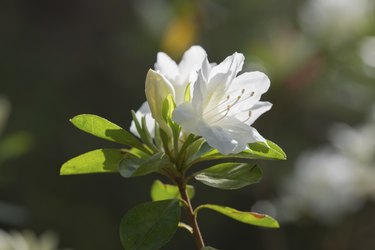
The azalea caterpillar (Datana major) is a redhead on a mission -- defoliating your plants. In late summer, these hungry pests can chew through leaves so fast they leave bare stems before you even notice their presence.
Plant Targets
Video of the Day
Named for the primary plants they favor, the red-headed azalea caterpillar munches on azalea (Rhododendron spp.) leaves growing in U.S. Department of Agriculture plant hardiness zones 4 through 9. But its common name doesn't restrict this caterpillar to azaleas only. These pests may also target other plants, particularly blueberry (Vaccinium spp.) in USDA zones 2 through 9. Occasionally, they'll also damage red oak (Quercus rubra) in USDA zones 4 through 8. Caterpillars damage plants that live in the north-south range of Maryland to Florida, and west to Kansas and Arkansas.
Video of the Day
Distinctive Look
The identifying red heads are only visible on mature azalea caterpillars. As the caterpillars progress through different life stages as immature larvae called instars, they undergo color changes. The instars first have black heads on yellow bodies, which are marked with seven red stripes that run longitudinally. As the caterpillars mature, their bodies are mainly black; the red stripes turn yellow and the black heads turn red. These caterpillars have a characteristically defensive behavior when disturbed -- they raise their heads and hindquarters to form a "U" shape.
Voracious Feeders
Azalea caterpillars hatch from eggs, which the azalea moth lays on the undersides of the plant's leaves. Hidden from view, the eggs hatch into the first instars that stay in clusters underneath the leaves as they begin to eat. These instars eat the tender plant cells between the leaf veins, skeletonizing the foliage. The mature caterpillars devour whole leaves. You won't see any damage until late summer, which gives the azalea caterpillar its nickname of "Labor Day worm."
Caterpillar Control
Azalea caterpillars are not venomous. The hairs that cover their bodies and their U-shaped posture are simply deterrents against predators. An effective, chemical-free control is handpicking the pests from your plants. For organic control, apply Bacillus thuringiensis to your plants using a handheld spray bottle, pressurized sprayer or a hose-end applicator. Typically, you mix 1/2 teaspoon to 4 teaspoons Bt per gallon of water, depending on the formulation. Bt kills the caterpillars by forming crystals in the stomach that pierce the gut. After you apply Bt, caterpillars stop feeding on plants, although they may linger up to several days before falling.
- Floridata: Rhododendron Spp.
- Penn State Extension: Blueberries
- Rainscaping.org: Vaccinium Angustifolium
- Floridata: Vaccinium Ashei
- Floridata: Vaccinium Corymbosum
- Missouri Botanical Garden: Quercus Rubra
- BugGuide: Species Datana Major -- Azalea Caterpillar Moth
- NC State University Cooperative Extension: Labor Day Worms Seem to be Arriving Earlier This Year
- University of Florida IFAS Extension: Azalea Caterpillar, Datana Major Grote and Robinson (Insecta: Lepidoptera: Notodontidae)